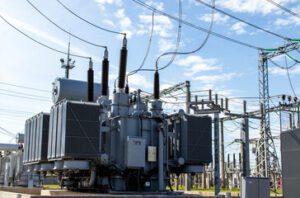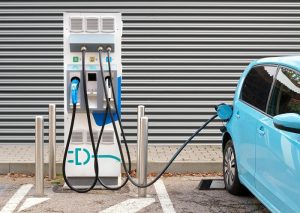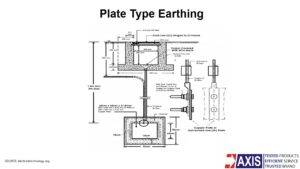You will spend approximately 18 to 20 crores on a 5 MW solar plant. Therefore, you need a smart strategy to produce profitable electricity and ensure your plant is safe for at least 25-30 years. What’s the secret? It’s quite simple – Earthing for Solar.
Firstly, setting up a solar farm is a huge investment, as it involves purchasing a large number of solar panels, inverters, and other expensive electrical equipment. Therefore, proper maintenance of a solar farm is important to extend its lifespan and ensure its efficiency. This maintenance includes regularly inspecting the solar panels, as well as checking the electrical wiring and earthing systems.
Talking about Earthing, it is the process of establishing an electrical connection between a conductive object, such as a solar panel, and the earth. This connection is important for many reasons but the most important is the protection of people and equipment from electrical shocks.
Improper earthing can expose solar panels and electrical equipment to damage from electrical surges, lightning strikes, and other disturbances. Such damages lead to the failure of solar panels, resulting in costly repairs or replacements. However, establishing an effective earthing connection safeguards your solar farms against electrical hazards, ensuring smooth operations.
Role of Earthing in Solar Farm
Earthing, also known as grounding, is the process of establishing an electrical connection between a conductive object, such as a solar panel, and the earth. This connection is important for a number of reasons, including protecting people and equipment from electrical shocks, dissipating electrical energy, and providing a reference point for electrical measurements.
Earthing is important for protecting the investment in a solar farm, as it can help to extend the life of the solar panels and other electrical equipment. Solar Farms have a high capital investment made with the idea that the farm will run for 30 years. When a solar farm is not earthed properly, the solar panels and other electrical equipment can be damaged by electrical surges, lightning strikes, and other electrical disturbances. This damage can reduce the efficiency of the solar panels, and can even cause them to fail prematurely, leading to costly repairs or replacements.
This example shows that electrical surges can be caused by a variety of factors, and that solar farms need to be properly earthed in order to protect their investment in solar panels and other equipment. By establishing an effective earthing connection, solar farms can protect their equipment from electrical surges and other electrical hazards, and ensure the safe and efficient operation of their solar farm.
How to Calculate Earthing for Solar Farm?

The Earthing requirements for solar panels are very specific. They vary based on the particular installation, as well as local electrical codes and regulations. To determine these requirements, you need to consider the soil’s earthing resistance, and the size and layout of the solar panel installation.
Based on these factors, the proper earthing electrodes and conductors should be selected, and the earthing system should be designed.
The general steps involved in calculating the earthing requirements for a solar farm are:
- Determine the earthing resistance: Earth resistance is the resistance between your earthing system and the ground. This can be calculated using a test instrument, such as an earth resistance tester, and should be measured at different points around the solar farm. We have a separate video on what Earth Resistance exactly means and how to measure it, the link is right here and also in the description. Click to watch our video on Resistance Measurement.
- Select the appropriate earthing electrodes: Based on the earthing resistance and the size and layout of the farm, the appropriate earthing electrodes should be selected. This may include earthing plates, earthing rods, or earthing pits, depending on the specific requirements of the solar farm.
- Design the earthing system: The earthing system should be designed to provide an effective earthing connection for solar panels and other electrical equipment. This may involve installing earthing electrodes at strategic locations around the solar farm, and connecting them to the solar panels and other equipment using copper or aluminium conductors.
- Test the earthing system: Once the earthing system has been installed, it should be tested to ensure that it provides an effective earthing connection for the panels and other equipment. This may involve using a test instrument, such as a ground resistance tester, to measure the earthing resistance at different points around the solar farm.
Talk to our engineers!
Earthing Design Standards for Solar Farms

Several earthing design guidelines and standards apply to solar farms. These documents offer guidance on designing, installing, and testing earthing systems. The standards specify requirements for selecting, designing, testing and installing earthing systems to confirm their effectiveness.
Covering the technical details of each standard is beyond the scope of this blog, it will take way too much time. However, these are the relevant standards that you can read in order to understand the earthing requirements.
- The International Electrotechnical Commission Standard – IEC 60364 & IEC 62561
- The British Standard BS 7430
- And The Institute of Electrical and Electronics Engineers -IEEE 2778-2020
How do Experts Calculate the Requirements?
An earthing expert can help with calculating the earthing requirements for a solar farm in a number of ways. First, they can provide guidance and expertise on the appropriate design and installation of the earthing system. This may involve recommending the use of certain types of grounding rods, grounding wires, or other conductive materials to ensure that the system meets the required specifications.
Second, an earthing expert can assist with performing calculations to determine the appropriate size and configuration of the earthing system for the specific solar farm. This may involve taking into account factors such as the size and type of the solar panels, the location of the solar farm, and other factors that can impact the earthing requirements.
Third, an earthing expert can help with performing tests to ensure that the earthing system is providing sufficient grounding for the solar panels and other equipment. This may involve using specialized equipment to measure the ground resistance and other parameters of the system, and to identify any areas where the system may not be meeting the required specifications.
Issues faced during Earthing

When it comes to a solar farm, meeting the earthing requirements means ensuring that the earthing system is properly designed and installed to provide sufficient grounding for the solar panels and other equipment.
If the earthing requirements for a solar farm are not met, it means that the earthing system may not be providing sufficient grounding for the solar panels and other equipment. This can increase the risk of electrical hazards and may result in reduced performance and reliability of the solar farm.
There are a number of reasons why a solar farm’s grounding system may not meet the required specifications. For example, the system may not have been properly designed or installed, or it may have been damaged or degraded over time. In some cases, the requirements for the earthing system may have changed since the solar farm was originally constructed, making it necessary to update the system to meet the new requirements.
Regardless of the specific reasons, it is important to address any issues with a solar farm’s earthing system to ensure that it is functioning properly and meeting the required specifications. This will help to ensure the safe and reliable operation of the solar farm, and to maximize its performance and efficiency.
If the earthing requirements for a solar farm cannot be met, it is important to take steps to address the issue. This may involve consulting with an electrical engineer or other qualified professional to determine the best course of action.
One possible solution would be to redesign the earthing system to meet the required specifications. This may involve adding additional grounding rods or other conductive materials to the system, or making other changes to the system’s design.
Another option would be to implement additional safety measures to protect against electrical hazards in the event that the earthing system is not functioning properly. This could include installing surge protectors on the solar panels and other equipment, or implementing regular testing and maintenance procedures to ensure that the earthing system is functioning as effectively as possible.
Ultimately, it is important to work with a qualified professional to determine the best course of action if the earthing requirements for a solar farm cannot be met. You can get in touch with our Expert Engineers for implementing the same.
Maintenance of Earthing for Solar Farm
To regularly inspect the earthing system for a solar park, you can follow these steps:
1) Locate the grounding rods and other components of the earthing system. These may be located near the base of each solar panel, or they may be grouped together in a central area of the solar park.
2) Visually inspect the grounding rods and other components of the earthing system to ensure that they are in good condition and properly connected. Look for signs of corrosion, wear, or damage, and make note of any issues that you find.
3) Use a ground resistance tester or other specialised equipment to test the earthing system to ensure that it is providing sufficient grounding for the solar panels and other equipment. This will help you to identify any areas where the system may not be working properly.
4) If you find any damaged or faulty components of the earthing system, make plans to repair or replace them as needed. This may involve replacing grounding rods that have corroded or grounding wires that have become frayed or disconnected.
5) If the earthing system is located in an area with a high water table or other potential sources of moisture, take steps to prevent moisture from affecting the system. This may include installing drain tiles or other moisture management systems around the grounding rods.
By regularly inspecting and testing the earthing system for a solar park, you can ensure that it is in good working order and is able to ground the solar panels and other equipment properly. This will help to protect against electrical hazards and improve the overall safety and reliability of the solar park.
Thank you for reading the blog, Axis is a leading manufacturer and supplier of Electrical Components to over 80+ Countries. You can also watch our videos by our experts – click here.
Follow us on LinkedIn for regular updates on our Products!








